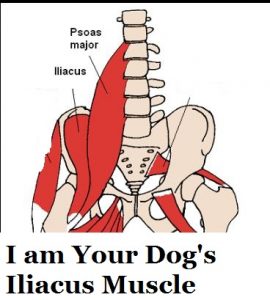Laurie's Blogs.
Jan 2017
Iliopsoas Strain, or is it?

Good Morning Laurie,
I down loaded your rehabilitation protocol for treating acute Iliopsoas strains which we will start incorporating into our program, however we deal with a lot of chronic Iliopsoas which are normally secondary to a hip or stifle dysfunction.
We will put our patients on tramadol for 6 weeks, a NsAID for 1 week and methocarbomal for 6 weeks along with either applying laser, ultrasound and or shockwave but I usually don't do any exercises except a strain counter strain ever time they come in for treatment. We do have the owners restrict their activities with no running, jumping or playing and I do have them apply heat to the Iliopsoas once a day followed by icing three hours later with a repeat icing four hours after the first icing.
So my questions is would you treat them differently than what I describe above or add/take away anything to our treatment? Most of our patients will have surgery to correct the hip or stifle dysfunction but I find that it takes up to 6 to 8 weeks before we can mostly or fully resolve the Iliopsoas strain.
Your input and thoughts would be appreciated at your convenience.
Sincerely,
CS
--- --- --- --- ---
Hi CS!
Thank you for the question (and I’m going to use it on the Forum) - it’s a good question, that I think others will benefit from!
So here goes:
In regards to your question, these cases, where the iliopsoas pain is secondary to a hip or stifle condition, are not strains. They would be overuse issues. It’s important to differentiate because the pathology is different and therefore the approach to treatment is different.
A strain would indicate torn muscle or tendon fibres. An overuse secondary to favouring a hindlimb joint dysfunction would be much more of a myofascial trigger point pathology.
So, your treatment strategy would be better suited to a true strain scenario.
To treat a secondary iliopsoas myofascial dysfunction, I would recommend the following:
1)Address the root of the problem (which is being done by surgery or whatever other therapies you are using for the offending joint.) I just thought it was smart to reiterate this point.
2)Continue to use modalities that will increase blood flow - laser, ultrasound, shockwave. Here, I would use higher doses of laser (10J/cm2 over multiple points) or shockwave (using 3.0 bar of pressure) or continuous wave ultrasound (for the heating effect).
3)Scrap the ice & heat in these cases… I don’t believe they are adding much to the overall healing.
4)Whatever meds would be useful to the underling joint issues, are good, but there is no need to medicate for the MTrP pathology. And there are no meds that will address it specifically.
5)Any stretching and specifically some slow myofascial hold-type stretches. One hand on the chest and one on the thigh and slowly push the two apart to allow some myofascial releases.
6)So long as the ‘joint issues at the root of the problem’ will allow, start specific exercises right away.
My favourite iliopsoas exercises:
- Lovin’ on the Stairs: Rear feet on the floor and front feet up on a higher step that causes the dog to stretch out. The provide praise, treats, or a toy to keep the dog in the position for longer.
- Cookies under the chest: To get the dog to round the spine and contract the iliopsoas as well as the abdominals.
- Rear Feet up reach and stretch: Set the dog up so his/her back feet are elevated on a step or stool, and then entice him/her to stretch forwards (and a little bit down towards the floor) to take a treat (sort of like doing a plank). Hold for a couple of seconds, then move the treat backwards, so they arch again (and contract the iliopsoas). This is an eccentric, then concentric exercise.
- If the hip or stifle issue is not too severe, or as it is healing from surgery, and it is time appropriate (i.e. 4 - 6 weeks post-op) then start some slow down hill or down stairs walking. Again, this will work the iliopsoas eccentrically.
Additionally, mobilize the lumbar spine. The iliopsoas is attaching to the ventral side of the vertebra, and can create a pull and some irritation / inflammation of the nerve roots. I would also laser over the dorsal surface of the lumbar spine for this reason as well.
So, all in all, don’t think of these cases as being strains. Think of them as nasty myofascial triggerpoint cases, and I think you will expedite your healing times immensely!
Thank you for asking this!
Cheers,
Laurie
--- --- --- --- ---
I agree with, and would like to echo, everything Laurie said except her comment that "where the iliopsoas pain is secondary to a hip or stifle condition, [they] are not strains". You can have both.
I treat all ilios, especially those secondary to LS, hip, or stifle issues, more or less as Laurie describes. If it works, great. If not, then I take them to ultrasound. If the ultrasound shows fiber disruption a/o hyopechoic lesions, then I've had best success with either ESWT or MSC/PRP combo. If the owners are able to afford it, then regen med is the way to go.
David Lane


